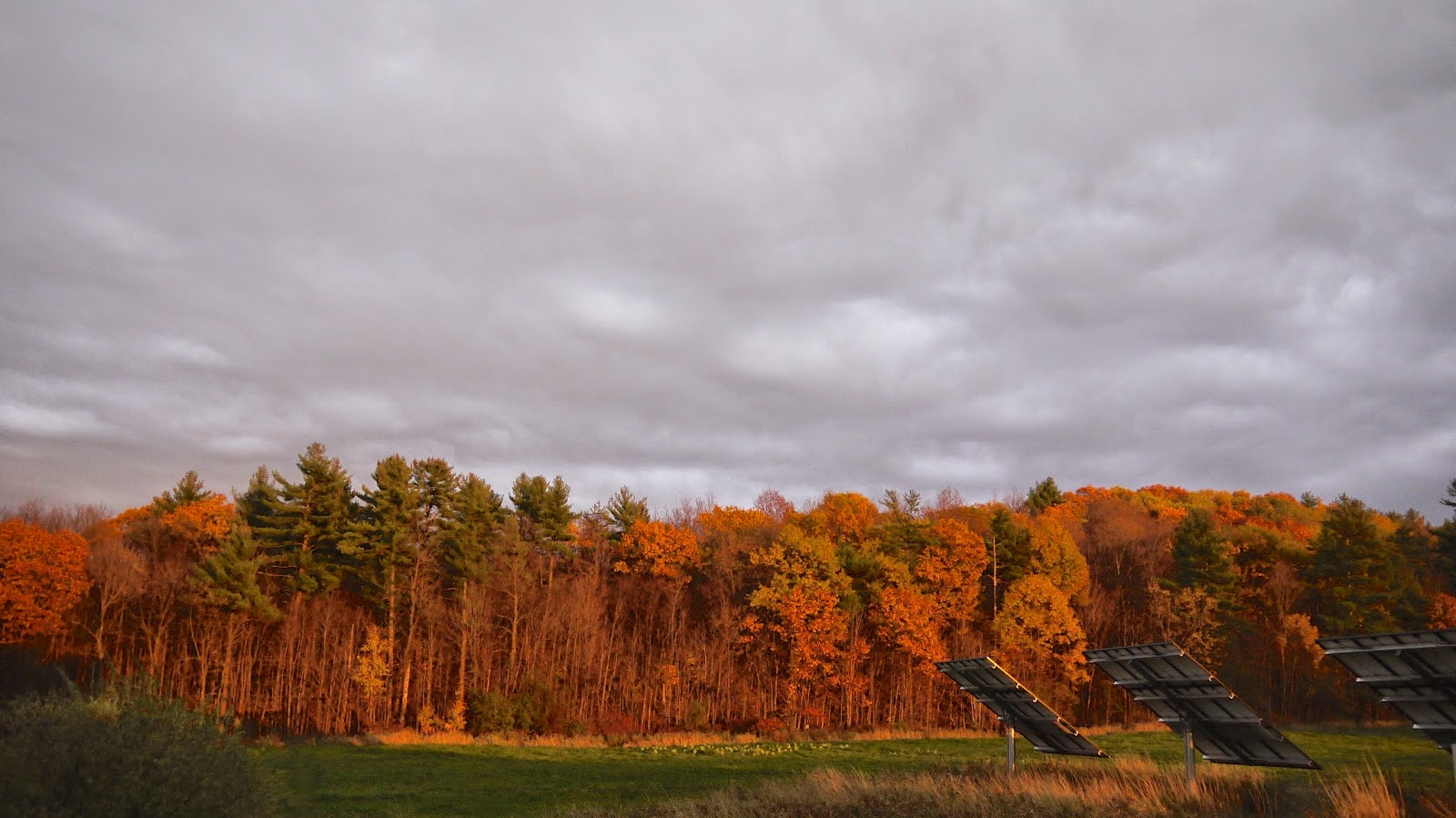WHITEOUT
It’s the
darkest time of the year.
I began
writing this on December 9 and 10––the two days of heavy wet snow that
blocked views of almost everything, mountains, trees, even our road––and that
storm was followed by days, no, weeks, of shrouded grayness that weighed down
the sky. A single sunny morning was an exception, soon forgotten. The solstice was still nearly two weeks away. All day long it looked like early evening.
 |
| Much cheerier: The same view, more or less, just before all the leaves fell. |
While we were
away for Christmas the snow melted away in several days of warmth and fog. When
the fog lifted and the sky cleared at last nearly all the whiteness had vanished. The ground lay bare, awaiting 2015 to whiten up again.
 |
| More of the same |
Nice as it
was to see white everywhere, this wasn’t the kind of snow we welcomed. Sure, it was attractive in the way it
coated the trees as if sprayed on–although it would have been really beautiful had the sun shined on it, just once–and loaded the firs so heavily that they
looked like the fir trees kids make around sandcastles on the beach by dripping
wet sand into little peaks. Firs
seldom look that perfect naturally.
The snow load was a painful burden to other trees: Higher up from here, in the mountains, you
would have heard the crack of limbs and tree trunks for hours through a day and
a And, chances are, you could
have been without electricity for as long as five days. Even the Middlebury Snow Bowl had to
close because of the lack of power. Forest trails were closed because of many
broken, fallen and partially fallen trees making them dangerous or impassible. Skinny and flexible trees, like
birches, spent nearly the whole period bent over, without a thaw to release the
pressure. Tree torture. In the valley damage was minimal, only the
occasional broken branch. Clearing the white stuff, though, was
dispiriting.
The “here,”
as in “nonewsfrom” was whited out, too.
I put it to a lingering aftereffect of our visit to Cambodia and
Vietnam, Cambodia especially, where life is so much harder for so many, and
where any actual “news” is likely to have a memorable impact on your
livelihood, your world. What
happened here seemed trivial in comparison. Hence, a mental kind of whiteout. Or blackout, maybe.
Or just a blank.
Or just a blank.
CONSIDERING ARMADILLOS
Where was
I? Oh right, the transformation of
everything here from white to, well, kind of brown and greenish. The snow vanished so quickly it was like
pulling off a blanket and realizing someone was asleep underneath. Suddenly
without cover, rodent trails were exposed everywhere, but most startlingly, near the pond. Every spring warm weather reveals their
wobbly pathways that used to be tunnels under the snow. On the far side of the pond I had never
noticed rodent signs before, and certainly not holes you could actually fall into. I
checked the internet for likely culprits.
The Center
for Wildlife Damage Management (who knew?) suggests one first look to see whether
or not there actually is a hole. Of
course I knew there was a hole. Holes. That was the point.
Nevertheless, I read on. “If there is no hole and just a
groove present, consider armadillos.”
Okay.
Next: Look for a hole that
may lead to a burrow. Measure the
hole. Three inches or less (there
were several of those) suggests chipmunk, crayfish (Really? Crayfish?),* ground squirrel, kangaroo rat, Norway rat,
skunks, or voles. Winnowing the
list of those from other habitats leaves chipmunks (who prefer living under the
bird feeder), skunks (not around in the cold, and even if they were, Skyler
would notice), rats (unlikely; no grain lying around, plus they prefer chicken
coops). That leaves voles.
 |
| The really big trails and hole: The tape gives a width of nine inches. At top is the frozen pond. |
Woodchuck,
groundhog, whistle-pig.
(Woodchucks, when threatened wil make a whistling noise to alert fellow
groundhogs.) A major business recently
built a factory in Middlebury to turn out Woodchuck Cider. The nearby town of Shoreham has a distillery that produces
Whistle-Pig rye whiskey. Another
name for woodchuck is land beaver.
I like that one.
*Yes, crayfish do in fact burrow in the ground near water.
Their two-inch burrow openings are surrounded by a ring of mud. But not here.





